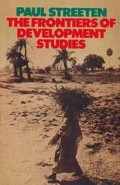Abstract
The first section is a brief introduction to the history of thought on this subject; the second section discusses measurement, projections and planning of qualified manpower. The third section is devoted to a critical survey of three approaches attempting to calculate returns to educational expenditure. The fourth section briefly summarises the main requirements of educational planning and the fifth section applies some of the conclusions to the area of rural education and rural reform. Sections 1 and 2 cover both advanced and underdeveloped countries, while sections 3 to 5 apply to underdeveloped countries only.
I am indebted to Clive Bell for valuable assistance, to Richard Jolly for valuable comments, and to the Bulletin of the Oxford University Institute of Economics and Statistics and the Journal of Development Studies for permission to use material published there. My main intellectual debt is to Lord Balogh whose contribution to thought on this subject has been pioneering.
Access this chapter
Tax calculation will be finalised at checkout
Purchases are for personal use only
Preview
Unable to display preview. Download preview PDF.
References
For a good summary, see John Vaizey, The Economics of Education (London: Faber & Faber, 1962) chap. 2, to which this section is indebted.
Alfred Marshall, Principles of Economics (London: Macmillan, 1880: 6th ed., 1910) p. 564.
Sidney Webb, London Education (London: 1904) p. 9, quoted by John Vaizey, op. cit., p. 7.
Hollis B. Chenery, ‘Patterns of Industrial Growth’, American Economic Review, 50, 4 (Sep 1960) pp. 624–65.
Herbert S. Parries, Forecasting Fdurational Needs for Economic and Social Development ( Paris, OECD, 1962 ) p. 35.
Jan Tinbergen and H. C. Bos, ‘A Planning Model for the Educational Requirements of Economic Growth’, pp. 9–31. In: OECD, Econometric Models of Education. Some Applications ( Paris: OECD, 1965 ) p. 99.
Russel G. Davis, Planning Human Resource Development. Educational Models and Schemata (Chicago: Rand McNally, 1966 ) p. 334.
Arnold C. Harberger, ‘Investment in Men Versus Investment in Machines: The Case of India’, pp. 11–50. In: C.,Amold Anderson and Mary Jean Bowman (eds.) Education and Economic Development ( Chicago: Aldine Publishing Co., 1965 ) p. 436.
Copyright information
© 1972 Paul Streeten
About this chapter
Cite this chapter
Streeten, P. (1972). Economic Development and Education. In: The Frontiers of Development Studies. Palgrave Macmillan, London. https://doi.org/10.1007/978-1-349-05017-8_8
Download citation
DOI: https://doi.org/10.1007/978-1-349-05017-8_8
Publisher Name: Palgrave Macmillan, London
Print ISBN: 978-0-333-27553-5
Online ISBN: 978-1-349-05017-8
eBook Packages: Palgrave Social & Cultural Studies CollectionSocial Sciences (R0)

